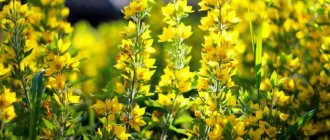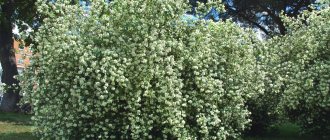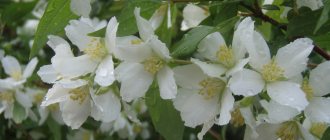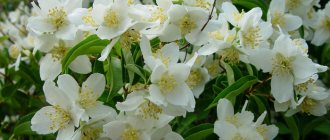The aroma and delicate beauty of mock orange, sometimes called garden jasmine, have made it a traditional decoration of gardens and parks for a long time. At one time, it began to get lost among the many new species of shrubs that appeared and were offered to gardeners. But in recent years, the mock orange has gained a second youth, many different forms of the plant have appeared, and the time has come for its renaissance.
Varieties of crown mock orange (Philadelphus coronarius)
In the middle zone, the crown mock orange blooms first - in early June (if the spring is warm, then at the end of May). This shrub grows quite quickly and can reach a height of 3 m. The plant lives for about 30 years. The most commonly cultivated ornamental varieties in gardens are:
Aureus
In spring, this shrub with a spherical crown is decorated with bright yellow leaves, and in summer and autumn they are yellowish-green. Thanks to its bright foliage, this mock orange is decorative all season, and not just during flowering, when it is covered with numerous simple white flowers with yellow stamens in the center, emitting a strong aroma. Mock orange Aureus grows well in sunny areas, and tolerates partial shade, but then blooms sparingly. After flowering it needs sanitary pruning.
Variegatus
This upright shrub reaches a height of 1.5 m. In addition to creamy-white fragrant flowers, it has very attractive slightly serrated leaves (up to 5-9 cm long) of variegated (and some completely white) colors.
Cultivation Secrets
Mock orange is one of the most unpretentious and easy to grow plants. Perhaps this is one of the reasons for such a wide distribution of mock orange in our gardens and parks. Most of its varieties grow well in both sun and partial shade. Mock orange also tolerates the frosty season well. Even if the branches freeze in the harsh winter, new shoots of restoration will emerge from the powerful root system in the spring.
Where to begin?
A sufficiently lit place is most suitable for planting mock orange. It tolerates slight shading well and grows even in the shade, but in such conditions the shoots of the plant become too elongated and flowering will not be abundant. Also, when choosing a place for planting, you should take into account that crown mock orange has a negative attitude towards the proximity of groundwater and stagnation of moisture in the soil.
Planting of seedlings can be done both in the fall, after leaf fall, and in the spring, before the leaves bloom. The depth and width of the planting hole should be at least half a meter, and to cover the root system, it is necessary to stock up on fertile soil or humus: the plant should be provided with soil nutrition for many years of its life.
For a single planted shrub, sufficient free space should be provided. There should be at least one and a half meters of free space around it. When planting plants in a row, in the form of a hedge, you must maintain an interval between bushes of 0.5 m to a meter.
First, drainage is placed at the bottom of the planting hole, then the seedling, spreading the roots evenly in the hole. Then the root system is sprinkled with fertile soil and the soil is well compacted. It is permissible to deepen the root collar by 2-3 cm, but no more, to avoid rotting. Planting is completed by abundant watering and mulching of the tree trunk circle.
How to care?
Caring for mock orange is not difficult. The most important thing for him is maintaining the water regime. As already mentioned, the plant does not tolerate stagnation of water, but it is also sensitive to its lack. Therefore, regular watering should be an important part of caring for mock orange. To ensure that moisture is used evenly, it is advisable to cover the tree trunk circle with a layer of mulch.
Good to know! It is great if compost is used as a mulching material, so the plant will be additionally supplied with organic substances.
In the year of planting, young bushes are not fed, so they take root better. In subsequent years, nitrogen fertilizers are applied at the beginning of the growing season, and phosphorus and potassium fertilizers are applied after flowering.
Corona mock orange bushes do not need systematic pruning: the plant is able to regulate its crown itself, taking on the correct beautiful shape. You just need to trim off the tips of the branches that have faded. This achieves greater decorativeness of the shrub in the summer, and the plant does not waste energy on the formation of fruits and seeds, directing more energy to the formation of flower buds and the development of leaf apparatus. Also, on the eve of winter, it is necessary to remove the unripe parts of the shoots: they will most likely die off in the winter. It is necessary to thin out and rejuvenate bushes that have been growing for a long time, in which the bush has become irregular in shape and some branches have become bare.
Varieties of Lemoine mock orange (Philadelphus lemoinei)
The French gardener Lemoine made a significant contribution to the spread of mock orange throughout the world, so an entire species is named after him. It includes hybrids of common mock orange and small-leaved mock orange. Lemoine mock orange is widespread in countries with temperate climates. True, plants of foreign selection are less winter-hardy, therefore they are more often cultivated in regions with a milder climate. However, they are so attractive that even in the middle zone, some gardeners are not lazy to grow these garden jasmines with winter shelter. They bloom in late June and July.
Virginal
This hybrid mock orange is also called maiden, virgin or innocent. The bush reaches a height of 2 m. During flowering, it is strewn with fragrant double flowers (about 5 cm in diameter), which are collected in inflorescences of 5-7 pieces.
Avalanche, or Avalanche
This mock orange has the smell of strawberries, which is why people often call it strawberry. The shrub (about 1.5 m high) has thin brown shoots, narrow light green leaves (2 cm long) and many simple white flowers (up to 3 cm in diameter), which are located in 1-3 pieces on short axillary shoots and exude a pleasant strawberry aroma. Lush flowering is observed in July.
The disadvantage of this plant is that it cannot withstand frosts below –15°C.
snow avalanche
Since the Avalanche variety turned out to be insufficiently winter-hardy for the middle zone, breeder N.K. Vekhov improved it and obtained an early-flowering winter-hardy variety, which he named Snow Avalanche. This is a more graceful shrub up to 1.5 m high with curved flowing branches, green leaves up to 4 cm long and numerous semi-double flowers (up to 3 cm in diameter), smelling of strawberries.
Moth Ballet
This variety is often mistakenly called Flight of Moths. A tall and powerful shrub is attractive for its asymmetrical shape of semi-double flowers of cream color and with a delicate aroma. The inflorescences protrude slightly above the leaves, so it seems that white butterflies are circling around the bush.
Airborne assault
On a compact bush (about 1.4 m high), thin branches bend under the weight of inflorescences (8-9 cm long) with 7-9 freely arranged small and simple flowers in the shape of a bowl. They resemble parachutes and also smell nice of strawberries.
Firework
A mock orange bush about 2.4 m high is strewn with numerous double flowers (4-4.5 cm in diameter) of white color with a delicate scent.
Komsomolets
The shrub reaches a height of 1.3 m. Its strong stems are located at an angle of 80 degrees. The shoots (about 10 cm long) are slightly curved upward. In mid-summer they are strewn with double flowers (about 4.5 cm in diameter) of snow-white color. The lower petals are oval, the inner ones are narrow and more oblong. Among them, yellow anthers are barely noticeable.
Chamomile
This variety is loved by many gardeners due to the unusual shape of the flowers. They are almost flat and at the same time with narrow and long petals. Externally, these flowers resemble chamomile - hence the name of the variety.
Snow Avalanche, Ballet of Moths, Airborne Assault, Salyut, Komsomolets, Romashka and other varieties of domestic selection are often combined into a group called “Vehova Varieties”. These are the most frost-resistant varieties of mock orange.
Mock oranges with two-color flowers are very decorative.
Bicolore
This plant has white flowers (about 5 cm in diameter) with a pink-burgundy core and golden stamens.
Reproduction methods
Video about mock orange Shneeshturm reports that the shrub can be propagated in several vegetative ways. When using any of them, jasmine takes root well and quickly begins to delight with abundant flowering.
Cuttings
The easiest way to increase the mock orange population on a site is with the help of green cuttings. The algorithm looks like this:
- In June, several young shoots up to 5 cm long are cut from an adult bush.
- Four leaves and an internode are left on each cutting.
- The top two plates are cut in half, and the bottom ones are removed.
- Treat the sections with a stimulating solution.
- The cuttings are planted in a temporary place in nutrient soil and covered with plastic bottles.
After the shoots begin to grow, they can be transferred to a permanent site.
It takes about a month for mock orange shoots to take root with regular watering.
Layerings
A simple way to propagate mock orange is to use flexible layering. The diagram looks like this:
- Last year's shoots are bent down and placed in shallow grooves.
- The branches are fixed and sprinkled with nutritious soil, leaving the tops above the surface.
- During the summer, the cuttings are watered abundantly.
With the onset of autumn, rooted shoots can be separated from the main bush.
In order for the layering to give roots faster, mock orange shoots can be slightly cut in the recessed part
Application in landscape design
The terry variety of mock orange Schneeshturm is used for several purposes:
- for forming a hedge;
Thick mock orange hides the area well from prying eyes - for decorating facades and fences;
White Shneeshturm bushes look impressive under the walls of buildings - to create compositions.
The rapidly growing Schneeshturm tolerates shaping and artistic pruning well.
You can combine an ornamental shrub with lilac, hydrangea or tall roses. It is better not to plant the Schneeshturm mock orange variety next to fruit plants; it will suppress their development.
Plant care procedure
Mock orange does not require close attention, but the necessary conditions should be observed:
- Every year, slurry is used as top dressing. The use of mineral fertilizers begins in the second year. Before flowering, a solution is prepared for 2 bushes: 15 grams of urea, 30 grams of superphosphate and 15 grams of potassium sulfate are added to 10 liters of water. After flowering - mixture per 1 sq. m of territory: 20 grams of superphosphate, 15 grams of potassium sulfate and 150 grams of wood ash.
- Watering is carried out in moderate amounts. After planting, 10-20 liters of water are poured under each bush. During the year, moisture is added as needed, but not more than 30 liters at a time under the bush. Humidification is carried out after sunset.
- Before planting, the branches of the seedling are cut off. Only 2 buds are left. Every year, branches are regularly pruned after flowering and before growth begins. Weak and dying shoots are also removed. If sanitary pruning is required, then up to 25% of the bush is cut out.
Diseases and pests
The Schneeshturm variety of garden jasmine is rarely affected by fungi and parasites. The main danger for him is:
- powdery mildew - the fungus can be recognized by a whitish coating on the leaves;
For powdery mildew, mock orange is sprayed with copper sulfate or Fundazol - aphid - the pest feeds on the sap of the plates, deforms them and impairs flowering;
Tobacco infusion or the drug Karbofos are good against aphids. - spider mite - a parasite that settles on mock orange in hot, dry weather and leaves a thin web and light spots on the leaves.
It is necessary to fight spider mites with Fitoverm or Akarin solutions
To prevent fungi and pests, you need to regularly thin out the bush and prevent the accumulation of plant debris at the roots. It is also necessary to combat waterlogging of the soil and loosen it.











